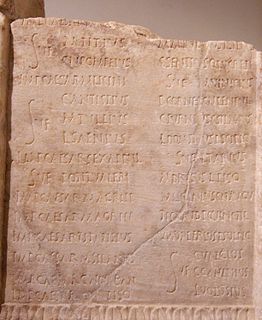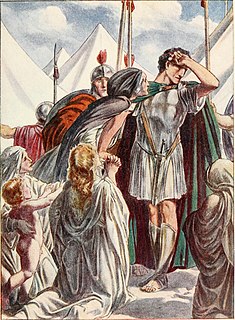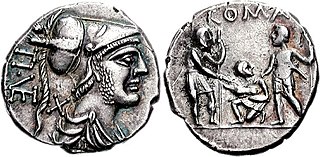Related Research Articles

Ancus Marcius was the legendary fourth king of Rome.Upon the death of the previous king, Tullus Hostilius, the Roman Senate appointed an interrex, who in turn called a session of the assembly of the people who elected the new king. Ancus is said to have ruled by waging war as Romulus did, while also promoting peace and religion as Numa did.

This article is about the fifth Roman King. For other articles about Roman kings named Tarquinius see Lucius Tarquinius Superbus. For other members of the Roman gen see Tarquinia (gens).

Numa Pompilius was the legendary second king of Rome, succeeding Romulus after a one-year interregnum. He was of Sabine origin, and many of Rome's most important religious and political institutions are attributed to him, such as the Roman Calendar, Vestal Virgins, the cult of Mars, the cult of Jupiter, the cult of Romulus, and the office of Pontifex Maximus.

The Sabines were an Italic people that lived in the central Apennine Mountains of ancient Italy, also inhabiting Latium north of the Anio before the founding of Rome.

The gens Aemilia, originally written Aimilia, was one of the greatest patrician families at ancient Rome. The gens was of great antiquity, and claimed descent from Numa Pompilius, the second King of Rome. Its members held the highest offices of the state, from the early decades of the Republic to imperial times. The Aemilii were almost certainly one of the gentes maiores, the most important of the patrician families. Their name was associated with two major roads, an administrative region of Italy, and the Basilica Aemilia at Rome.
Gaius Papirius was Pontifex Maximus in 509 BC, the first year of the Roman Republic. He copied the religious ordinances established by Numa Pompilius, the second King of Rome, which his grandson, Ancus Marcius, had carved on oaken tablets, and placed in the Forum.

The gens Marcia, occasionally written Martia, was one of the oldest and noblest houses at ancient Rome. They claimed descent from the second and fourth Roman Kings, and the first of the Marcii appearing in the history of the Republic would seem to have been patrician; but all of the families of the Marcii known in the later Republic were plebeian. The first to obtain the consulship was Gaius Marcius Rutilus in 357 BC, only a few years after the passage of the lex Licinia Sextia opened this office to the plebeians.
The gens Quinctilia, also written Quintilia, was a patrician family at Rome, dating from the earliest period of Roman history, and continuing well into imperial times. Despite its great antiquity, the gens never attained much historical importance. The only member who obtained the consulship under the Republic was Sextus Quinctilius Varus in 453 BC. The gens produced numerous praetors and other magistrates, but did not obtain the consulship again for over four hundred years.
The gens Pinaria was one of the most ancient patrician families at Rome. According to tradition, the gens originated long before the founding of the city. The Pinarii are mentioned under the kings, and members of this gens attained the highest offices of the Roman state soon after the establishment of the Republic, beginning with Publius Pinarius Mamercinus Rufus, consul in 489 BC.
Numa Marcius, son of Marcus, was the first Pontifex Maximus of Ancient Rome.
The gens Gegania was an old patrician family at Rome, which was prominent from the earliest period of the Republic to the middle of the fourth century BC. The first of this gens to obtain the consulship was Titus Geganius Macerinus in 492 BC. The gens fell into obscurity even before the Samnite Wars, and is not mentioned again until the final century of the Republic.
Mamercus is a Latin praenomen, or personal name, which was used in pre-Roman times and throughout the Roman Republic, falling out of usage in imperial times. The feminine form is Mamerca. The patronymic gens Mamercia was derived from this name, as were the cognominaMamercus and Mamercinus. The name was usually abbreviated Mam.
Quintus is a Latin praenomen, or personal name, which was common throughout all periods of Roman history. It was used by both patrician and plebeian families, and gave rise to the patronymic gentes Quinctia and Quinctilia. The feminine form is Quinta. The name was regularly abbreviated Q.

The gens Veturia, originally Vetusia, was an ancient patrician family of the Roman Republic. According to tradition, the armourer Mamurius Veturius lived in the time of Numa Pompilius, and made the sacred ancilia. The Veturii occur regularly in the Fasti Consulares of the early Republic, with Gaius Veturius Geminus Cicurinus holding the consulship in 499 BC. Like other old patrician gentes, the Veturii also developed plebeian branches. The family declined in the later Republic, with the last consular Veturius holding office in 206 BC, during the Second Punic War.

The gens Pomponia was a plebeian family at ancient Rome. Its members appear throughout the history of the Roman Republic, and into imperial times. The first of the gens to achieve prominence was Marcus Pomponius, tribune of the plebs in 449 BC; the first who obtained the consulship was Manius Pomponius Matho in 233 BC.

The gens Lucretia was a prominent family of the Roman Republic. Originally patrician, the gens later included a number of plebeian families. The Lucretii were one of the most ancient gentes, and the second wife of Numa Pompilius, the second King of Rome, was named Lucretia. The first of the Lucretii to obtain the consulship was Spurius Lucretius Tricipitinus in 509 BC, the first year of the Republic.
The gens Gallia was a plebeian family at Rome. Several members of this gens are mentioned during the first century BC.
The gens Tarpeia was a minor patrician family at ancient Rome. Only a few members of this gens are known, and the Tarpeii vanish from history after the early Republic. The Tarpeian Rock, a promontory on the Capitoline Hill, from which those condemned for treason were thrown to their deaths, is said to have been named after Tarpeia, the archetype of all Roman traitors. There seems to have been a senatorial family of this name in imperial times.
The gens Manilia was a plebeian family at ancient Rome. Members of this gens are frequently confused with the Manlii, Mallii, and Mamilii. Several of the Manilii were distinguished in the service of the Republic, with Manius Manilius obtaining the consulship in 149 BC; but the family itself remained small and relatively unimportant.
The gens Sabidia was an obscure plebeian family at ancient Rome. Few members of this gens are mentioned in ancient writers, but a number are known from inscriptions.
References
- ↑ Dictionary of Greek and Roman Biography and Mythology, vol. III, p. 492 ("Pompilia Gens").
- ↑ Livy, i. 10-14, 17-21.
- ↑ Dictionary of Greek and Roman Biography and Mythology, vol. II, pp. 1212, 1213 ("Numa Pompilius").
- ↑ Livy, i. 20.
- ↑ Plutarch, "The Life of Numa", 21.
- ↑ Dictionary of Greek and Roman Biography and Mythology, vol. I, pp. 30, 168, 582 ("Aemilia Gens", "Ancus Marcius", "Calpurnia Gens"), vol. II, p. 940 ("Marcia Gens"), vol. III, pp. 366, 367, 492, 493 ("Pinaria Gens", "Pompilia Gens", "Pomponia Gens").
- ↑ Grueber, Coins of the Roman Republic, ii. p. 311, no. 733; p. 361, no. 62.
- ↑ Grant, Roman Myths, pp. 123, 139.
- ↑ Livy, iv. 44.
- ↑ Quintus Cicero, De Petitione Consulatus, 3.
- ↑ Suetonius, De Illustribus Grammaticis, 8.
- ↑ Institutes of Justinian, iii. tit. 9., pp. 414, 415 (ed. Sandars).